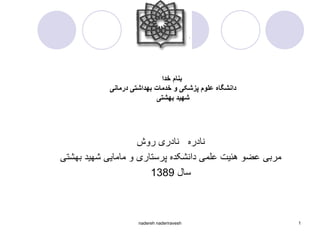
Water disorders
- 1. بنام خدا دانشگاه علوم پزشکی و خدمات بهداشتی درمانی شهید بهشتی نادره نادری روش مربی عضو هئیت علمی دانشکده پرستاری و مامایی شهید بهشتی سال 9831 nadereh naderiravesh 1
- 2. اعمال آب در بدن انتقال مواد به داخل و خارج بدن دفع مواد زاید بدن محیطی برای سوخت و ساز بدن تنظیم درجه حرارت بدن تامین حجم خون کمک به هضم مواد غذایی حالل مواد مختلف nadereh naderiravesh 2
- 3. BODY FLUIDS INTRACELLULAR FLUID (ICF) 28 L EXTRACELLULAR FLUID(ECF) 14 L ECF INTERSTITIAL FLUIDS (8 L) INTRACELLULAR FLUIDS (6L) nadereh naderiravesh 3
- 4. NORMAL FLUID INTAKE & OUTPUT ROUTE INTAKE ML Water in food 1000 Water from oxidation 300 Water as liquid 1200 Total = 2500 nadereh naderiravesh 4
- 5. OUTPUT ROUTE ML Skin 300 Lungs 500 Feces 200 kidney 1500 Total = 2500 nadereh naderiravesh 5
- 6. release Regulation of body fluid volume Hypervolemia Hypovolemia inhibits Stimulate Aldestron ADH release ADH Aldestron Thirst release Thirst release release Urination Normal fluid volume restored nadereh naderiravesh urination6
- 7. FLUID VOLUME DEFICIT (FVD) Causes: Vomiting Diarrhea Gastrointestinal suction Sweating Decrease intake Movment of fluid from vascular system to other body spaces( edema formation in burns, ascites) nadereh naderiravesh 7
- 8. Clinical manifestations Thirst Weight loss Decrease urine output Increase Urine specific gravity( over 1.030) Increase HR Decrease BP Fever Dry mucous membranes Decrease skin turgor Change in level of consciousness nadereh naderiravesh 8
- 9. MANAGEMENT Fluids Oral IV Ringer lactated %0/9 NACL Hypotonic solution ( %0,45 NACL) nadereh naderiravesh 9
- 10. بررسی و شناخت بیمار د رکمبود حجم مایعات بدن بررسی جذب و دفع مایعات بدن بررسی وزن روزانه بررسی عالیم حیاتی بررسی سطح هوشیاری بیمار بررسی تورگور پوست بررسی مخاط دهان و زبان بررسی وزن مخصوص ادرار nadereh naderiravesh 01
- 11. مراقبت در کمبود حجم مایعات بدن اندازه گیری جذب و دفع مایعات بدن تامین و جایگزینی مایعات از دست رفته کنترل عالیم حیاتی بیمار مراقبت از دهان دادن استراحت به بیمار عدم استفاده از مایعات محرک( در صورت مصرف مایعات از راه دهان ) رساندن مایعات از راه ورید در صورت عدم مصرف مایعات از راه دهان ) nadereh naderiravesh 11
- 12. FLUID VOLUME EXCESS(F.V.E) ETIOLOGY: Excess intake of fluids Excess intake of sodium CHF ( congestive heart failure ) Renal failure nadereh naderiravesh 12
- 13. Clinical manifestations Weight gain I&O Bounding pulse Increase hand time > 5 seconds Dyspnea Cough Crackles Jugular vein distention Edema Increase BP nadereh naderiravesh 13
- 14. MANAGEMENT Daily weights Strict I&O Reduce fluid intake Reduce sodium intake Diuretics Monitor electrolytes Elevate legs Encourage movement nadereh naderiravesh 14
- 15. مراقبت در افزایش حجم مایعات بدن کنترل دقیق جذب و دفع مایعات و ثبت آن کنترل مرتب الکترولیت های سرم محدودیت در مصرف مایعات و سدیم تجویز دیورتیک طبق دستور پزشک بررسی بیمار از نظر افزایش حجم مایعات ( بررسی از نظر ادم ، صداهای تنفسی و وزن ) قرار دادن بیمار در وضعیت نیمه نشسته ( در صورت وجود اشکال تنفسی ) nadereh naderiravesh 51
- 16. nadereh naderiravesh 16
- 17. nadereh naderiravesh 17